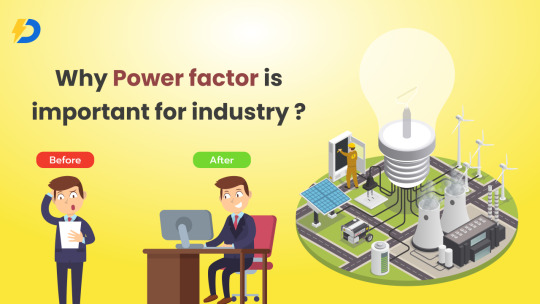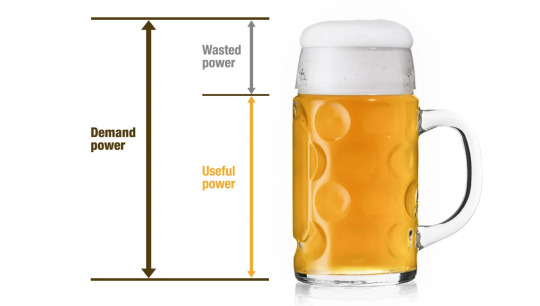#IndustrialIoT hashtag
Explore tagged Tumblr posts
Text

What are the most effective methods for managing power factor in your system?
`What's Power Factor?
In an energy management system, the power factor gauges the efficiency of electrical power usage. It is defined as the ratio of real power to apparent power (the total power supplied). A high power factor signifies efficient use of electrical power, which minimizes energy losses and enhances system performance.

Beer is active power (kW)—the useful power, or the liquid beer, is the energy that is doing work. This is the part you want.
Foam is reactive power (kVAR)—the foam is wasted power or lost power. It’s the energy being produced that isn't doing any work, such as the production of heat or vibration.
The mug is apparent power (kVA)—the mug is the demand power, or the power being delivered by the utility.
Understanding Low Power Factor?
A low power factor is primarily caused by inductive loads, including motors, transformers, and lighting ballasts, which draw reactive power. This reactive power is essential for generating and sustaining magnetic fields but does not contribute to useful work, increasing apparent power and consequently lowering the power factor. Moreover, harmonics from nonlinear loads, such as electronic devices and variable frequency drives, further reduce the power factor by introducing additional reactive power.
Benefits of High Power Factor
A high power factor decreases the apparent power and current drawn from the source, which can lower energy bills as some utilities impose charges for low power factor or provide incentives for maintaining a high power factor. It enhances voltage regulation and stability, increases system capacity and efficiency by reducing losses and heating, and lessens the effects of harmonics, thereby improving overall power quality.Benefits of Power Factor

Measuring Power Factor
Power factor is measured using a power meter or analyzer that monitors real, reactive, and apparent power, or with a power factor meter for direct readings. Measurements should be taken at various points in the system and at different times to account for load variations.
Correcting Low Power Factor
The most effective way to correct a low power factor is by installing power factor correction devices such as capacitors or synchronous condensers. These devices provide reactive power locally, reducing the flow of reactive power and improving the power factor. Depending on the load characteristics and desired power factor levels, they can be installed centrally or near specific inductive loads.
Controlling Power Factor Correction Devices
Power factor controllers, which can be either manual or automatic, are used to manage correction devices. Manual controllers rely on human adjustments based on meter readings, whereas automatic controllers use sensors and microprocessors to adjust devices. Automatic controllers can also be programmed to optimize performance under varying load conditions.
Optimizing Power Factor Management
Optimizing power factor management requires balancing cost, performance, maintenance, and safety. Essential practices include regular evaluation and adjustment, proper maintenance to prevent overloading and overheating, and compliance with utility codes and standards. This comprehensive approach ensures improved efficiency, stability, and cost-effectiveness of your electrical system.
#SmartEnergy hashtag#Sustainability hashtag#RenewableEnergy hashtag#EnergyEfficiency hashtag#SmartMeterRevolution hashtag#Niraltek hashtag#NiraltekTeam hashtag#InternetOfThings hashtag#ESP32 hashtag#ESP32Development hashtag#ESP32Project hashtag#ConnectedDevices hashtag#IoTInnovation hashtag#IoTProject hashtag#IoTDevices hashtag#IoTSecurity hashtag#IoTApplications hashtag#IoTDevelopment hashtag#IoTTechnology hashtag#ESP32Electronics hashtag#ESP32Innovation hashtag#IIoTTechnology hashtag#IIoTInnovation hashtag#IndustrialIoT hashtag#EnergyUsage hashtag#IoT hashtag#SmartCities hashtag#SmartMeter hashtag#powerfactor
0 notes
Text
From Factory Floor to Online Store: Mastering Industrial eCommerce for Growth
From catalogs to clicks! Discover how the digital shift in industrial eCommerce offers unprecedented opportunities for manufacturers. Read our latest blog for detailed insights. https://www.diginyze.com/blog/from-factory-floor-to-online-store-mastering-industrial-ecommerce-for-growth/

#DigitalTransformation hashtag#B2BEcommerce hashtag#B2B hashtag#HeadlessCommerce hashtag#ArtificialIntelligence hashtag#AI hashtag#AIineCommerce hashtag#MachineLearning hashtag#AugmentedReality hashtag#VirtualReality hashtag#IndustrialIoT hashtag#IIoT hashtag#OmnichannelStrategy hashtag#CustomerExperience hashtag#EcommerceTechnology hashtag#DigitalManufacturing hashtag#OnlineBusinessGrowth hashtag#EcommerceSolutions hashtag#TechInManufacturing hashtag#SmartManufacturing hashtag#FutureOfManufacturing
0 notes